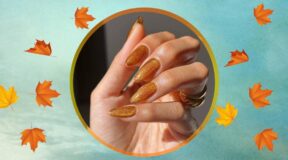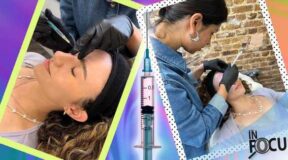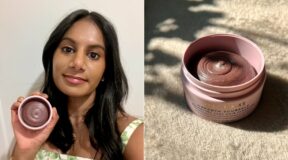You probably know someone who bites their nails. Heck, it's so common you might even do it yourself. But while you might dismiss it as just a 'bad habit,' it's actually categorized as a Body-Focused Repetitive Behavior (BFRB) — a general term for a group of related disorders that involve the manipulation of hair or skin on the body.
"Common BFRBs include, but are not limited to hair pulling, skin picking, nail-biting, nail/cuticle picking, acne picking, scab picking, lip biting, and cheek biting," explains Suzanne Mouton-Odum, Ph.D., psychologist and co-chair of the TLC Foundation for BFRBs Scientific Advisory Board.
I happen to know firsthand what it's like to live with one. I pull my hair out — specifically my eyelashes — due to a condition called trichotillomania. I've had trichotillomania for over a decade with long periods of recovery and relapses. And since BFRBs thrive during periods of stress and isolation, as you can imagine, the Covid-19 pandemic hasn't been ideal for most of us living with one.
Since there's a lot of stigma that surrounds this disorder, I talked to fellow trichsters, as we call ourselves, about their experiences to help demystify the condition. There's no better time to become an ally — BFRB Awareness Week is happening right now, until October 7.
What Is Trichotillomania?
I know, I can barely pronounce it either. About five to 10 million people in the United States, or roughly 3.5% of the population, meet the clinical criteria for trichotillomania, or hair-pulling disorder, according to the American Psychological Association.
"Trichotillomania is a psychological condition in which a person pulls their hair — scalp, eyelashes, eyebrows, pubic hair, arm hair, leg hair, or facial hair — to the extent that it causes some degree of interference in their ability to function and they are not able to stop themselves from pulling," Mouton-Odum tells InStyle.
Trichotillomania tends to develop right before or during their early teens and can be brought on by stress and anxiety, according to Mayo Clinic. This was the case for me. My trichotillomania symptoms started when I was eight when dealing with severe social anxiety in elementary school.
I remember sitting in the cafeteria before school started and my friend's mother said, "Sweetie, where are your eyelashes?" I was petrified and had no clue what she was talking about. I went to the bathroom and realized they were gone. I was so confused how this had happened.
This is a common experience. "Those with trichotillomania often enter a trance-like state where they are completely focused on pulling, oftentimes not even knowing they are doing it," says Kristin Gill, M.D., Deputy Director of Inpatient Mental Health at Woodhull Medical Center. "People become fixated on finding the 'right' hair to pull and it becomes very difficult to stop once having started."
It sounds unbelievable, but those with trich know the struggle: It feels that if you just pulled that certain eyelash, the urge would go away — but that's not true. In reality, it's an excuse to keep pulling.
How Covid-19 Has Made Things Worse
While there isn't concrete data, practitioners like Mouton-Odum have noticed an increase in patients reporting trich symptoms during the pandemic. "The uptick in trich is likely due to people feeling isolated, having increased alone time, and experiencing feelings of depression, uncertainty, and fears of what will happen in the future," Mouton-Odum says.
The pandemic has certainly been a trigger for my trichotillomania, and that seems to be the case for others with the condition, too. "I have noticed dramatic changes since the pandemic. I pull much more [when I'm] thinking about getting sick and catching Covid-19," Mary, 17, tells InStyle. "My pulling got so bad that I had bald spots — as big as my hand — on the sides of my head."
Jade, a 39-year-old teacher, has also noticed some of the same trich problems arising from her new virtual WFH environment. "If my trichotillomania was bad before COVID, it definitely increased during the pandemic. Sitting alone in my study all day staring at my computer screen with students reduced to words in a chat box gave me less to focus on. My stress levels were rocketing as I tried to keep my days organized whilst homeschooling my own children too," she says. "Being alone, I could really ramp up the pulling out of my hair as nobody was watching, and I was so miserable and lonely that I wanted to do it more and more."
When I was in an office, the pressure of my colleagues around prevented me from touching my eyes out of fear of judgment, but these days, I'm isolated at my desk with essentially just my thoughts and feelings, making it much easier for an episode to begin without me even realizing it. At the same time though, I've also struggled with anxiety brought on by our new WFH Zoom culture. For most people with trichotillomania, hair pulling is something done in private. I never pull in public, but only in my room when I'm alone. (I don't even pull in front of loved ones who know about my condition — that's how secretive I am.) Having a camera constantly turned on has increased my anxiety, because if I fall into a trance while in a meeting, then everyone will see up close what I'm doing. For me, it's all contributed to even more pulling.
Picture it: Since I've been writing this article, I've stopped numerous times to touch and pull my eyelashes.
How Trichotillomania Affects Mental Health and Self-Esteem
Many people with trichotillomania feel shame and embarrassment and it can take a huge toll on self-esteem because let's face it — having long, voluminous eyelashes and hair is a societal beauty standard. Pulling your hair out goes against this very principle.
"Girls 'normally' have long pretty hair, but I never wear my hair down because it is so lopsided and uneven," Vanessa, 24, tells InStyle. "It's so embarrassing. Every time my hair is down I get asked if I just got it cut."
People are constantly questioning your appearance and pointing out your insecurities (which is why many people with trich try to hide their hair loss by wearing hats or false eyelashes and eyebrows). One time, while giving each other 'makeovers' at a sleepover in elementary school, my friend noticed I had no eyelashes. Her first reaction was, "Ew, gross. What happened to your eyes?" Looking back, I know she didn't mean anything bad by it, but it still hurt. The other girls came to look, and there I was singled out in front of everyone. This happened at school, doctor's appointments (yes, really), and even from strangers. So it's safe to say I never really wanted to leave my house or look people in the eyes, literally.
Does Trichotillomania Ever Go Away?
There is a light at the end of the tunnel for those who suffer from trichotillomania. Let me rephrase that — there are ways to cope and resources to turn to when relapse happens.
"Cognitive Behavior Therapy (CBT) is the first-line intervention for BFRBs. Medication for anxiety or depression can also be helpful if a person is also suffering with an anxiety or depressive disorder," Mouton-Odum says. "A trained therapist can help put together a comprehensive treatment plan to help a person predict when the BFRB is likely to happen, employ targeted strategies to help them successfully be in that situation without engaging in the BFRB, and find other, less harmful ways to get their needs met. Treatment is effective, but it requires hard work and daily practice to get good at it."
I can attest to therapy being extremely helpful in reducing symptoms of trichotillomania, but it does require a lot of determination and grit. If you're reading this article, then you're probably headed in the right direction on the road to recovery.
The women I talked to for this story shared some coping mechanisms that have helped them on their journey. "I love any stress toys! Popits, squishy things, rings. All of those help distract my hands which delay the pulling," Mary says.
While fidget toys help for some, mindfulness has helped others to recognize familiar patterns of when they are likely to engage in the behavior. "When I see my hand go towards my eyes, I acknowledge that and try my best to put them down," Melani, 20, says.
That's definitely easier said than done. To go along with this mindfulness recognition, I've found it helpful to have a Keen bracelet, made specifically for people with BFRBs by the company HabitAware. They buzz when your hands are in your trigger area so you can take a second to re-assess. I've found this bracelet to be extremely effective in noticing patterns, plus it even has an app to show you your progress and determine patterns.
As much as I hate to admit it, living with trich means you'll probably have good and bad periods and that's okay. As long as you're doing your best, that's all that matters. You're not alone and I see you.
To find more information about BFRB's and trichotillomania, the TLC Foundation for BFRB's has a wide variety of resources from support groups to treatment referrals to help you out.
Source: Read Full Article





